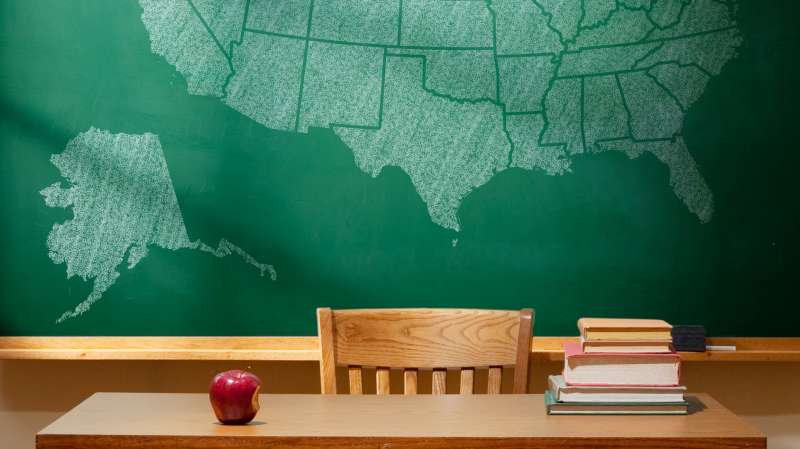The Best and Worst Places to Live for a Low-Cost College Education

Want to cut your family’s college tuition bills by more than $50,000? Bring up your kids in Wyoming. Or Florida. Or even New York. But not New Hampshire.
Using new College Board data on the average cost of tuition and fees at public colleges in all 50 states and the average amount of state tax dollars that go toward higher education, Money calculated where parents would spend the most and least to raise two children and send both to an in-state public university.
Wyoming, which the Tax Foundation reports has the lowest total tax burden in the country, is also the nation’s best bargain in higher education, thanks to the lowest public-college tuition in the U.S. Yet low taxes alone aren't enough to make a state a good deal. Although New Hampshire has the sixth-lowest tax burden in the nation, Granite State parents face the highest college-related bills.
To estimate the total cost of a public education in each state, Money calculated how much a family earning $50,000 a year would likely pay in state taxes earmarked for higher education over 25 years, and added that to four years of in-state tuition for two children. This back-of-the-envelope analysis, of course, assumes no change in prices or taxes, nor any financial aid.
The results, while rough, do a reasonable job of showing the impact of different philosophies toward government services, says Andy Carlson, senior policy analyst at the State Higher Education Executive Officers Association.
You'll generally pay more if you live in a state where the students who earn the benefits of the degree have to pay the bulk of the costs, Carlson says. And you'll usually—though not always—face lower overall college costs in states that view access to higher education as a public good, and as a result direct significant tax support to public universities.
The Best Places to Live
For families, how this difference usually plays out is in higher or lower in-state tuition. And you'll end up paying the most for your kids' education in states with high in-state tuition, even if those states have comparatively low college-related taxes.
New Hampshire has no tax on earned income. It funds government services with taxes on things like investment income, real estate, and liquor. For a family earning $50,000, the amount of state revenues that support the state's colleges equates to about $82 this year, or a little more than $2,000 over 25 years. Not surprisingly, New Hampshire has the highest average public college tuition in the country—$14,712 this year—pushing total higher education tuition and tax spending for parents of two children to more than $132,000 over two decades.
Wyoming, which has low direct taxes on its residents, funds much of its government services with taxes on mineral and energy mining. Out of those revenues, it allocates the equivalent of nearly $600 a year per family to higher education, the highest subsidy in the nation. As a result, tuition and fees at the University of Wyoming are just $4,646. The total higher education taxes and tuition costs for a typical Wyoming family adds up to just $42,000—or $90,000 less than New Hampshire families pay.
Some high-tax and high-subsidy states are bad deals for parents, however. Illinois taxpayers, for example, spend 13% more than the national average on higher education support—about $340 a year per middle-class family. And Illinois public colleges charge some of the highest tuition in the U.S. As a result, Illinois has the nation's fifth-highest combined tax-and-tuition bill for a typical family—$115,000.
In contrast, a middle class household North Carolina contributes about $500 worth of state taxes to higher education annually. That high level of taxpayer support helps keep North Carolina’s in-state tuition, $6,700 this year, below the national average. The total higher education tax and tuition costs for parents with two children comes in at about $60,000.
One last surprising note: You don’t have to travel far to reap big savings. Moving across the river from high-tax New Jersey, for example, to slightly higher-tax New York cuts the public college tuition you’re likely to pay by about $5,000 a year, and a family's total lifetime higher education bill by more than $50,000.
The 50-State Ranking
Here’s how the math plays out in all 50 states. For more on finding a great college value, check out our Best Colleges rankings, including the 25 Best Public Colleges.
| State | State higher-ed spending per $1,000 in personal income | 25-year total state higher-ed spending for families earning $50,000 | Average in-state tuition 2014-15 | Estimated total tuition costs for two children | Total estimated tuition + taxes |
|---|---|---|---|---|---|
| 1. Wyoming | $11.92 | $14,896 | $4,646 | $37,168 | $41,814 |
| 2. Alaska | $10.48 | $13,101 | $6,138 | $49,105 | $55,243 |
| 3. Utah | $7.63 | $9,537 | $6,177 | $49,416 | $55,593 |
| 4. New Mexico | $11.51 | $14,387 | $6,190 | $49,523 | $55,714 |
| 5. Montana | $5.70 | $7,125 | $6,279 | $50,233 | $56,512 |
| 6. Florida | $4.84 | $6,048 | $6,351 | $50,808 | $57,159 |
| 7. Nevada | $4.49 | $5,616 | $6,418 | $51,341 | $57,759 |
| 8. Idaho | $6.59 | $8,236 | $6,602 | $52,816 | $59,418 |
| 9. West Virginia | $7.80 | $9,753 | $6,661 | $53,292 | $59,953 |
| 10. North Carolina | $9.62 | $12,027 | $6,677 | $53,418 | $60,096 |
| 11. Mississippi | $9.50 | $11,877 | $6,861 | $54,888 | $61,749 |
| 12. Oklahoma | $6.52 | $8,145 | $6,895 | $55,157 | $62,052 |
| 13. New York | $4.91 | $6,134 | $7,292 | $58,338 | $65,631 |
| 14. Louisiana | $5.98 | $7,471 | $7,314 | $58,510 | $65,824 |
| 15. Nebraska | $8.07 | $10,093 | $7,404 | $59,234 | $66,638 |
| 16. North Dakota | $10.02 | $12,522 | $7,513 | $60,106 | $67,620 |
| 17. Arkansas | $8.01 | $10,013 | $7,567 | $60,535 | $68,102 |
| 18. South Dakota | $5.04 | $6,303 | $7,653 | $61,224 | $68,877 |
| 19. Iowa | $5.92 | $7,402 | $7,857 | $62,857 | $70,714 |
| 20. Kansas | $6.06 | $7,577 | $8,086 | $64,684 | $72,770 |
| 21. Georgia | $7.31 | $9,139 | $8,094 | $64,753 | $72,847 |
| 22. Missouri | $4.02 | $5,023 | $8,383 | $67,068 | $75,451 |
| 23. Tennessee | $6.25 | $7,810 | $8,541 | $68,324 | $76,865 |
| 24. Maryland | $5.42 | $6,771 | $8,724 | $69,790 | $78,514 |
| 25. Wisconsin | $4.51 | $5,632 | $8,781 | $70,248 | $79,029 |
| 26. Texas | $5.78 | $7,226 | $8,830 | $70,637 | $79,467 |
| 27. Oregon | $4.01 | $5,018 | $8,932 | $71,453 | $80,385 |
| 28. Indiana | $6.69 | $8,363 | $9,023 | $72,182 | $81,205 |
| 29. California | $5.84 | $7,306 | $9,173 | $73,381 | $82,554 |
| 30. Kentucky | $7.44 | $9,301 | $9,188 | $73,508 | $82,696 |
| 31. Maine | $4.99 | $6,243 | $9,422 | $75,378 | $84,800 |
| 32. Alabama | $8.18 | $10,220 | $9,470 | $75,759 | $85,229 |
| 33. Colorado | $2.78 | $3,479 | $9,487 | $75,897 | $85,384 |
| 34. Hawaii | $8.08 | $10,106 | $9,740 | $77,921 | $87,661 |
| 35. Ohio | $4.42 | $5,526 | $10,100 | $80,799 | $90,898 |
| 36. Arizona | $3.57 | $4,468 | $10,398 | $83,181 | $93,578 |
| 37. Minnesota | $5.42 | $6,780 | $10,527 | $84,217 | $94,744 |
| 38. Connecticut | $4.63 | $5,782 | $10,620 | $84,957 | $95,577 |
| 39. Washington | $4.81 | $6,017 | $10,846 | $86,765 | $97,610 |
| 40. Virginia | $4.40 | $5,503 | $10,899 | $87,192 | $98,091 |
| 41. Rhode Island | $3.45 | $4,316 | $10,934 | $87,469 | $98,403 |
| 42. Massachusetts | $2.88 | $3,605 | $10,951 | $87,608 | $98,559 |
| 43. Delaware | $5.44 | $6,798 | $11,448 | $91,581 | $103,029 |
| 44. South Carolina | $5.38 | $6,729 | $11,449 | $91,594 | $103,044 |
| 45. Michigan | $4.31 | $5,386 | $11,909 | $95,271 | $107,180 |
| 46. Illinois | $6.77 | $8,467 | $12,770 | $102,156 | $114,926 |
| 47. New Jersey | $3.99 | $4,993 | $13,002 | $104,020 | $117,022 |
| 48. Pennsylvania | $3.02 | $3,775 | $13,246 | $105,967 | $119,213 |
| 49. Vermont | $3.21 | $4,018 | $14,419 | $115,353 | $129,773 |
| 50. New Hampshire | $1.64 | $2,050 | $14,712 | $117,698 | $132,411 |
Sources: College Board, Money calculations
